Report: Paediatric Clinical Scenario - Rohan and Diabetes Management
VerifiedAdded on 2019/11/12
|11
|2310
|262
Report
AI Summary
This report presents a paediatric clinical scenario involving a 9-year-old boy named Rohan who has type 1 diabetes mellitus. Rohan's situation is complicated by his family's vegetarian diet, his mother's illness and depression, and his own independent management of his condition. The report outlines a clinical reasoning framework, identifies three nursing care priorities: educating the patient and family about diabetes, addressing unstable glucose levels, and counselling Rohan's mother. It also discusses strategies to build trusting relationships, including cultural competency therapy, family-centered care, and interpersonal communication therapy. The literature review supports these strategies. Finally, the report analyzes the interventions and effectiveness of the proposed care plan. This assignment is valuable for healthcare students and professionals. Access more assignments and study materials on Desklib.
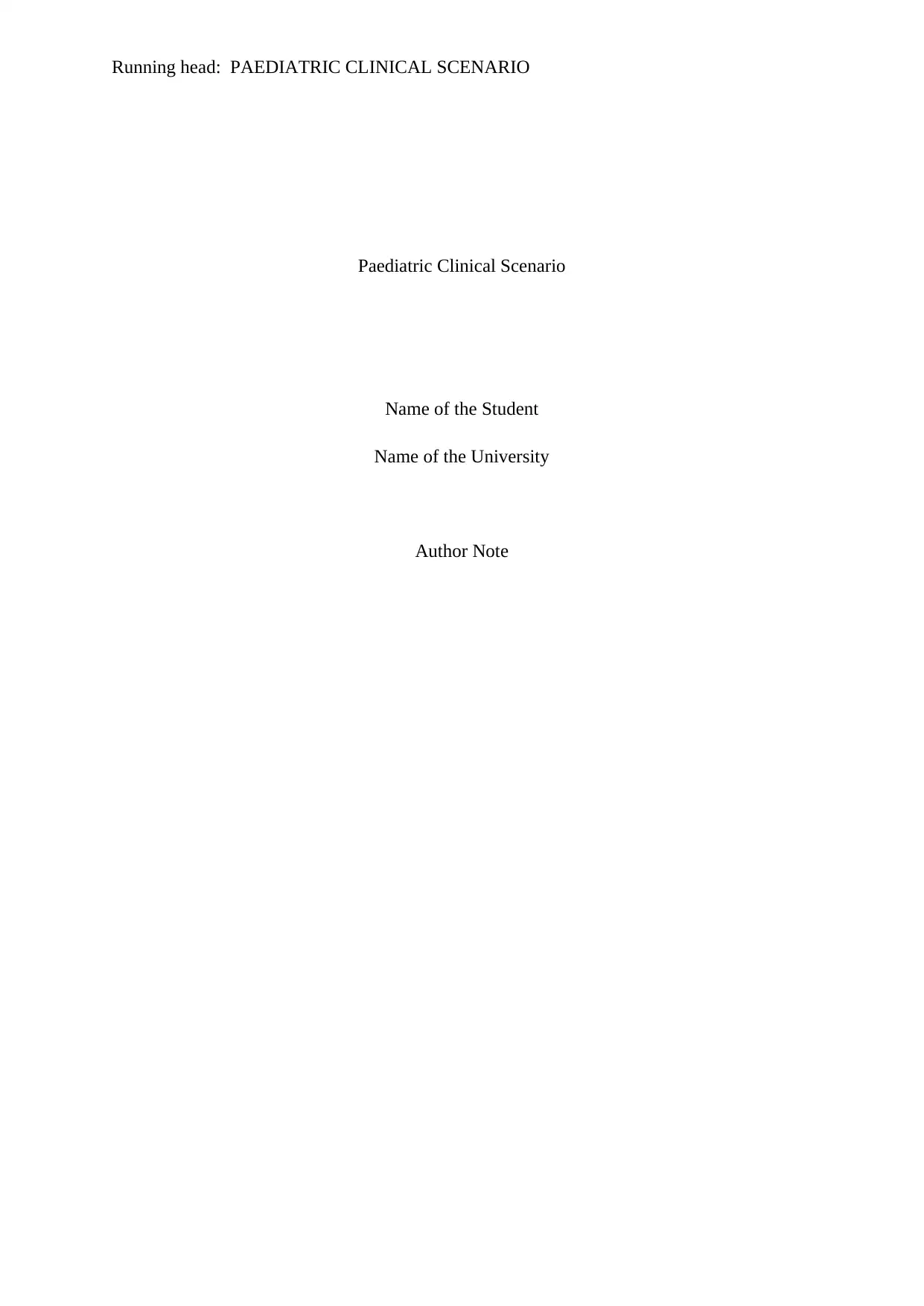
Running head: PAEDIATRIC CLINICAL SCENARIO
Paediatric Clinical Scenario
Name of the Student
Name of the University
Author Note
Paediatric Clinical Scenario
Name of the Student
Name of the University
Author Note
Paraphrase This Document
Need a fresh take? Get an instant paraphrase of this document with our AI Paraphraser
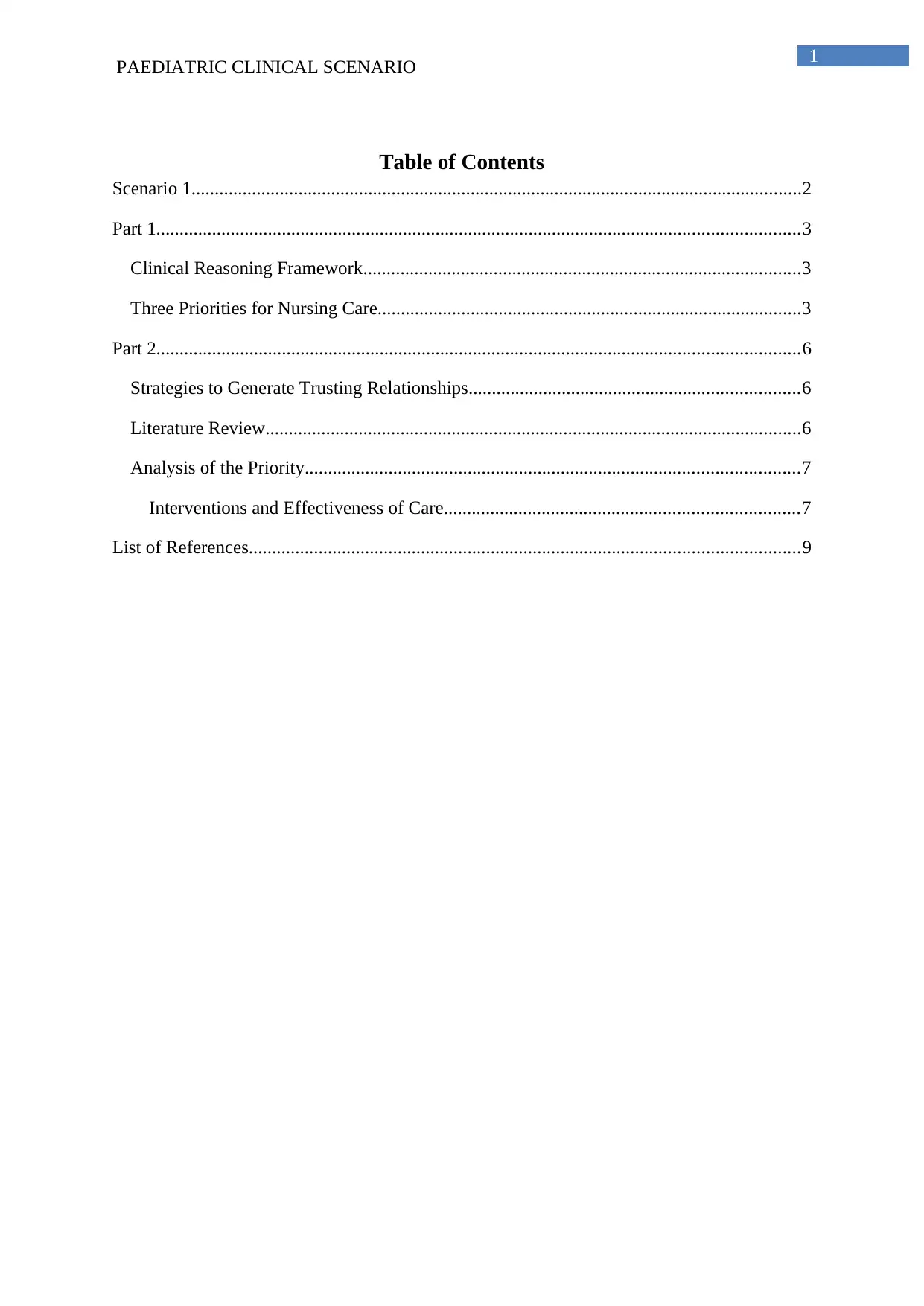
1
PAEDIATRIC CLINICAL SCENARIO
Table of Contents
Scenario 1...................................................................................................................................2
Part 1..........................................................................................................................................3
Clinical Reasoning Framework..............................................................................................3
Three Priorities for Nursing Care...........................................................................................3
Part 2..........................................................................................................................................6
Strategies to Generate Trusting Relationships.......................................................................6
Literature Review...................................................................................................................6
Analysis of the Priority..........................................................................................................7
Interventions and Effectiveness of Care............................................................................7
List of References......................................................................................................................9
PAEDIATRIC CLINICAL SCENARIO
Table of Contents
Scenario 1...................................................................................................................................2
Part 1..........................................................................................................................................3
Clinical Reasoning Framework..............................................................................................3
Three Priorities for Nursing Care...........................................................................................3
Part 2..........................................................................................................................................6
Strategies to Generate Trusting Relationships.......................................................................6
Literature Review...................................................................................................................6
Analysis of the Priority..........................................................................................................7
Interventions and Effectiveness of Care............................................................................7
List of References......................................................................................................................9
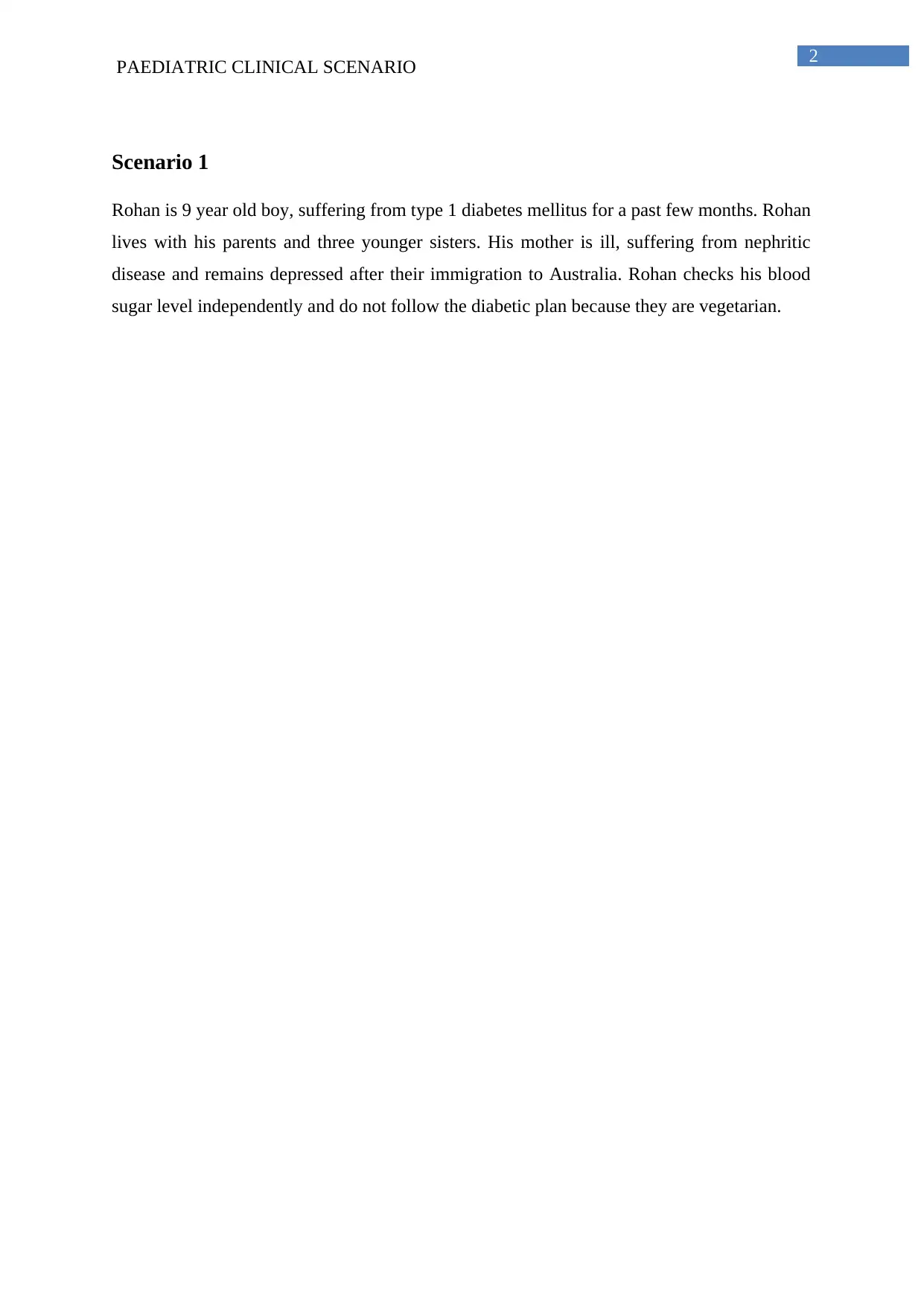
2
PAEDIATRIC CLINICAL SCENARIO
Scenario 1
Rohan is 9 year old boy, suffering from type 1 diabetes mellitus for a past few months. Rohan
lives with his parents and three younger sisters. His mother is ill, suffering from nephritic
disease and remains depressed after their immigration to Australia. Rohan checks his blood
sugar level independently and do not follow the diabetic plan because they are vegetarian.
PAEDIATRIC CLINICAL SCENARIO
Scenario 1
Rohan is 9 year old boy, suffering from type 1 diabetes mellitus for a past few months. Rohan
lives with his parents and three younger sisters. His mother is ill, suffering from nephritic
disease and remains depressed after their immigration to Australia. Rohan checks his blood
sugar level independently and do not follow the diabetic plan because they are vegetarian.
⊘ This is a preview!⊘
Do you want full access?
Subscribe today to unlock all pages.

Trusted by 1+ million students worldwide
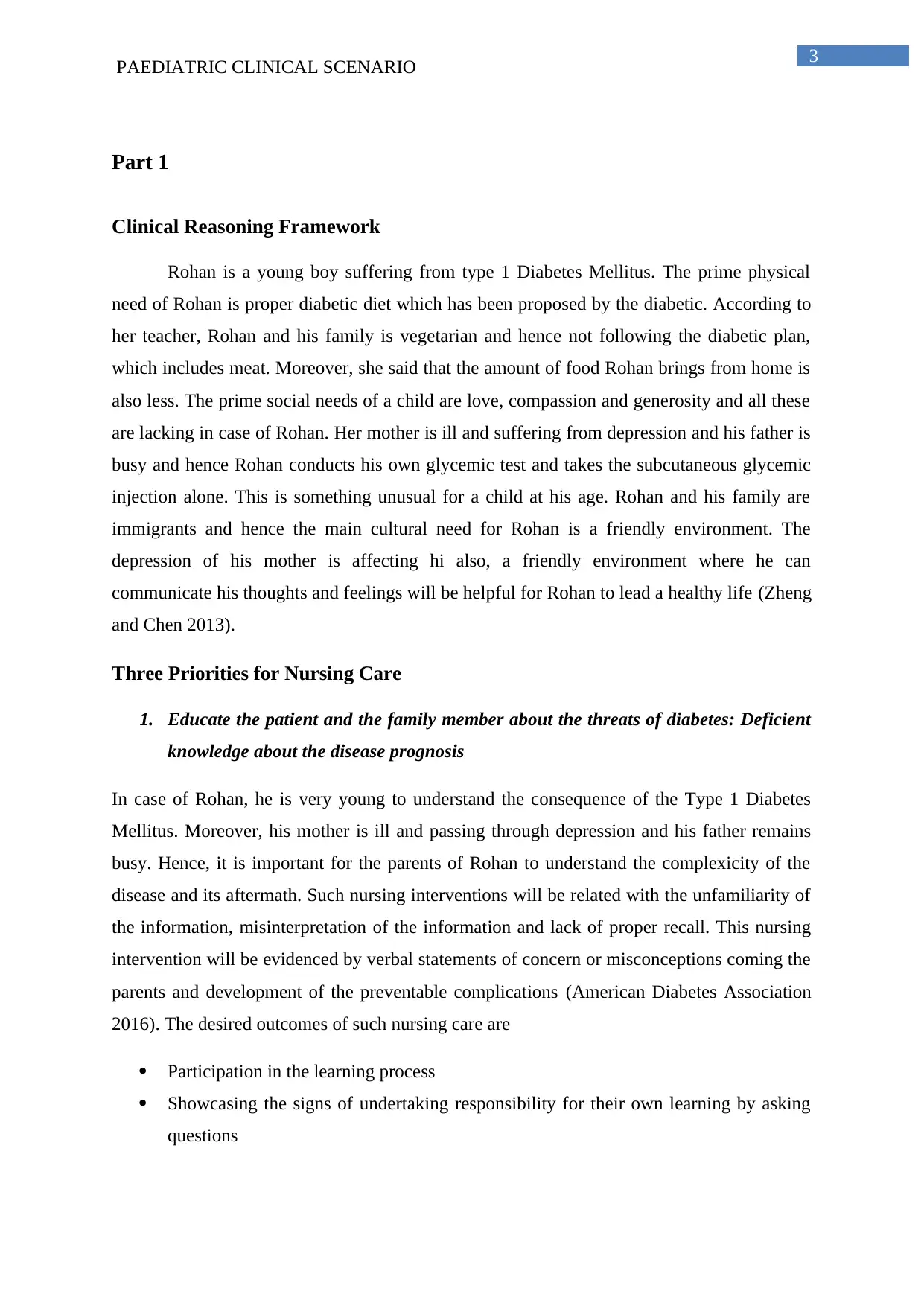
3
PAEDIATRIC CLINICAL SCENARIO
Part 1
Clinical Reasoning Framework
Rohan is a young boy suffering from type 1 Diabetes Mellitus. The prime physical
need of Rohan is proper diabetic diet which has been proposed by the diabetic. According to
her teacher, Rohan and his family is vegetarian and hence not following the diabetic plan,
which includes meat. Moreover, she said that the amount of food Rohan brings from home is
also less. The prime social needs of a child are love, compassion and generosity and all these
are lacking in case of Rohan. Her mother is ill and suffering from depression and his father is
busy and hence Rohan conducts his own glycemic test and takes the subcutaneous glycemic
injection alone. This is something unusual for a child at his age. Rohan and his family are
immigrants and hence the main cultural need for Rohan is a friendly environment. The
depression of his mother is affecting hi also, a friendly environment where he can
communicate his thoughts and feelings will be helpful for Rohan to lead a healthy life (Zheng
and Chen 2013).
Three Priorities for Nursing Care
1. Educate the patient and the family member about the threats of diabetes: Deficient
knowledge about the disease prognosis
In case of Rohan, he is very young to understand the consequence of the Type 1 Diabetes
Mellitus. Moreover, his mother is ill and passing through depression and his father remains
busy. Hence, it is important for the parents of Rohan to understand the complexicity of the
disease and its aftermath. Such nursing interventions will be related with the unfamiliarity of
the information, misinterpretation of the information and lack of proper recall. This nursing
intervention will be evidenced by verbal statements of concern or misconceptions coming the
parents and development of the preventable complications (American Diabetes Association
2016). The desired outcomes of such nursing care are
Participation in the learning process
Showcasing the signs of undertaking responsibility for their own learning by asking
questions
PAEDIATRIC CLINICAL SCENARIO
Part 1
Clinical Reasoning Framework
Rohan is a young boy suffering from type 1 Diabetes Mellitus. The prime physical
need of Rohan is proper diabetic diet which has been proposed by the diabetic. According to
her teacher, Rohan and his family is vegetarian and hence not following the diabetic plan,
which includes meat. Moreover, she said that the amount of food Rohan brings from home is
also less. The prime social needs of a child are love, compassion and generosity and all these
are lacking in case of Rohan. Her mother is ill and suffering from depression and his father is
busy and hence Rohan conducts his own glycemic test and takes the subcutaneous glycemic
injection alone. This is something unusual for a child at his age. Rohan and his family are
immigrants and hence the main cultural need for Rohan is a friendly environment. The
depression of his mother is affecting hi also, a friendly environment where he can
communicate his thoughts and feelings will be helpful for Rohan to lead a healthy life (Zheng
and Chen 2013).
Three Priorities for Nursing Care
1. Educate the patient and the family member about the threats of diabetes: Deficient
knowledge about the disease prognosis
In case of Rohan, he is very young to understand the consequence of the Type 1 Diabetes
Mellitus. Moreover, his mother is ill and passing through depression and his father remains
busy. Hence, it is important for the parents of Rohan to understand the complexicity of the
disease and its aftermath. Such nursing interventions will be related with the unfamiliarity of
the information, misinterpretation of the information and lack of proper recall. This nursing
intervention will be evidenced by verbal statements of concern or misconceptions coming the
parents and development of the preventable complications (American Diabetes Association
2016). The desired outcomes of such nursing care are
Participation in the learning process
Showcasing the signs of undertaking responsibility for their own learning by asking
questions
Paraphrase This Document
Need a fresh take? Get an instant paraphrase of this document with our AI Paraphraser
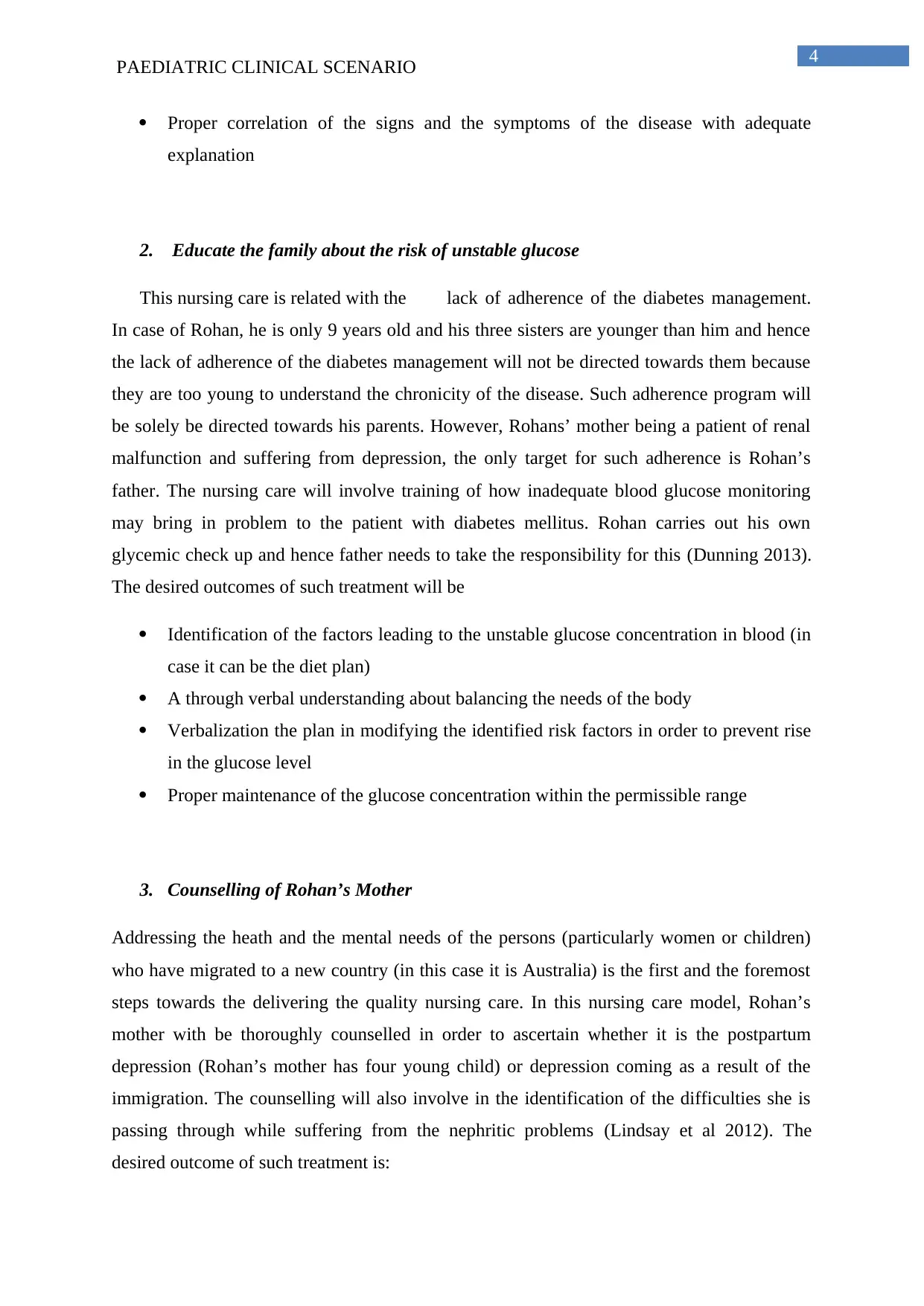
4
PAEDIATRIC CLINICAL SCENARIO
Proper correlation of the signs and the symptoms of the disease with adequate
explanation
2. Educate the family about the risk of unstable glucose
This nursing care is related with the lack of adherence of the diabetes management.
In case of Rohan, he is only 9 years old and his three sisters are younger than him and hence
the lack of adherence of the diabetes management will not be directed towards them because
they are too young to understand the chronicity of the disease. Such adherence program will
be solely be directed towards his parents. However, Rohans’ mother being a patient of renal
malfunction and suffering from depression, the only target for such adherence is Rohan’s
father. The nursing care will involve training of how inadequate blood glucose monitoring
may bring in problem to the patient with diabetes mellitus. Rohan carries out his own
glycemic check up and hence father needs to take the responsibility for this (Dunning 2013).
The desired outcomes of such treatment will be
Identification of the factors leading to the unstable glucose concentration in blood (in
case it can be the diet plan)
A through verbal understanding about balancing the needs of the body
Verbalization the plan in modifying the identified risk factors in order to prevent rise
in the glucose level
Proper maintenance of the glucose concentration within the permissible range
3. Counselling of Rohan’s Mother
Addressing the heath and the mental needs of the persons (particularly women or children)
who have migrated to a new country (in this case it is Australia) is the first and the foremost
steps towards the delivering the quality nursing care. In this nursing care model, Rohan’s
mother with be thoroughly counselled in order to ascertain whether it is the postpartum
depression (Rohan’s mother has four young child) or depression coming as a result of the
immigration. The counselling will also involve in the identification of the difficulties she is
passing through while suffering from the nephritic problems (Lindsay et al 2012). The
desired outcome of such treatment is:
PAEDIATRIC CLINICAL SCENARIO
Proper correlation of the signs and the symptoms of the disease with adequate
explanation
2. Educate the family about the risk of unstable glucose
This nursing care is related with the lack of adherence of the diabetes management.
In case of Rohan, he is only 9 years old and his three sisters are younger than him and hence
the lack of adherence of the diabetes management will not be directed towards them because
they are too young to understand the chronicity of the disease. Such adherence program will
be solely be directed towards his parents. However, Rohans’ mother being a patient of renal
malfunction and suffering from depression, the only target for such adherence is Rohan’s
father. The nursing care will involve training of how inadequate blood glucose monitoring
may bring in problem to the patient with diabetes mellitus. Rohan carries out his own
glycemic check up and hence father needs to take the responsibility for this (Dunning 2013).
The desired outcomes of such treatment will be
Identification of the factors leading to the unstable glucose concentration in blood (in
case it can be the diet plan)
A through verbal understanding about balancing the needs of the body
Verbalization the plan in modifying the identified risk factors in order to prevent rise
in the glucose level
Proper maintenance of the glucose concentration within the permissible range
3. Counselling of Rohan’s Mother
Addressing the heath and the mental needs of the persons (particularly women or children)
who have migrated to a new country (in this case it is Australia) is the first and the foremost
steps towards the delivering the quality nursing care. In this nursing care model, Rohan’s
mother with be thoroughly counselled in order to ascertain whether it is the postpartum
depression (Rohan’s mother has four young child) or depression coming as a result of the
immigration. The counselling will also involve in the identification of the difficulties she is
passing through while suffering from the nephritic problems (Lindsay et al 2012). The
desired outcome of such treatment is:
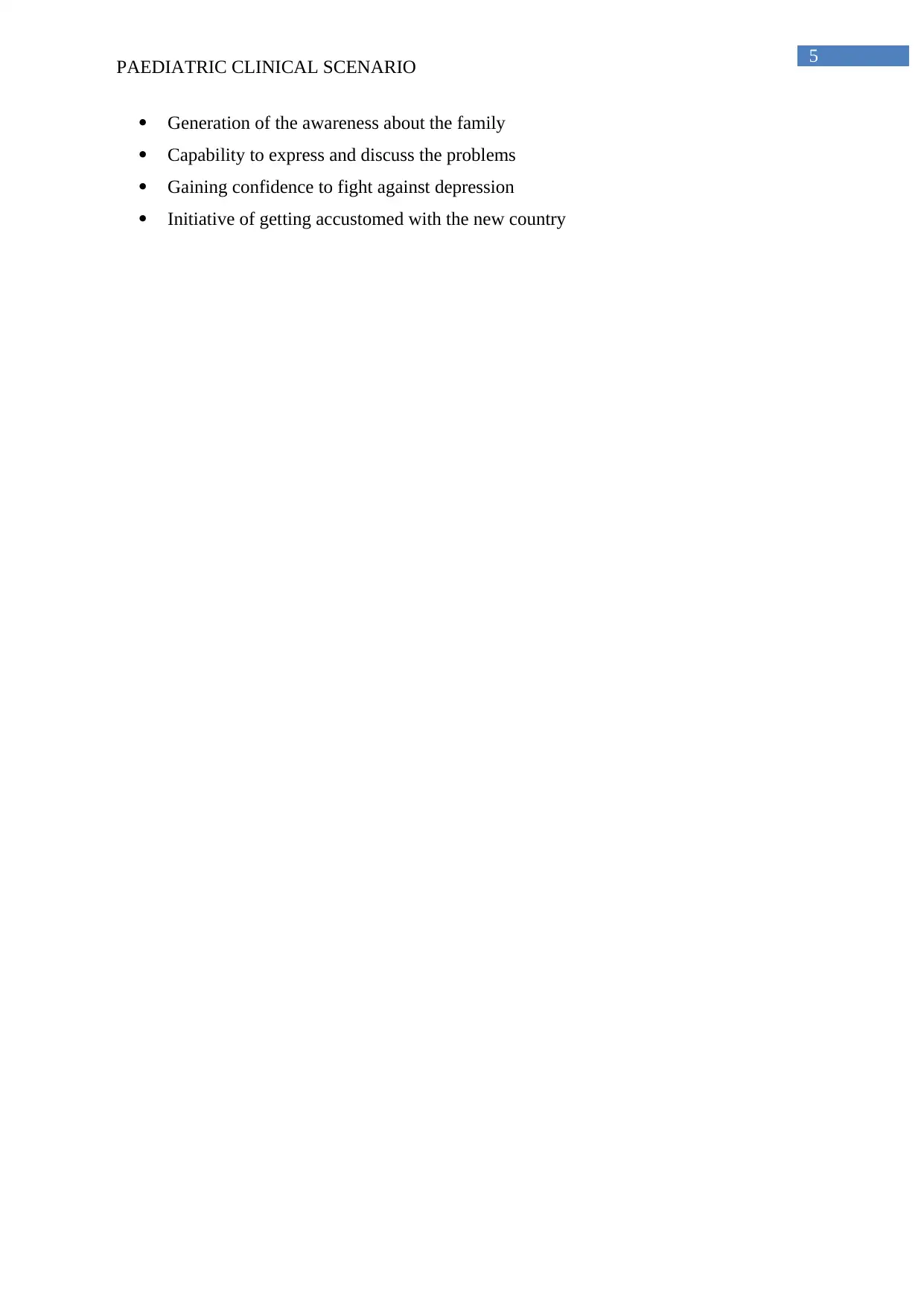
5
PAEDIATRIC CLINICAL SCENARIO
Generation of the awareness about the family
Capability to express and discuss the problems
Gaining confidence to fight against depression
Initiative of getting accustomed with the new country
PAEDIATRIC CLINICAL SCENARIO
Generation of the awareness about the family
Capability to express and discuss the problems
Gaining confidence to fight against depression
Initiative of getting accustomed with the new country
⊘ This is a preview!⊘
Do you want full access?
Subscribe today to unlock all pages.

Trusted by 1+ million students worldwide
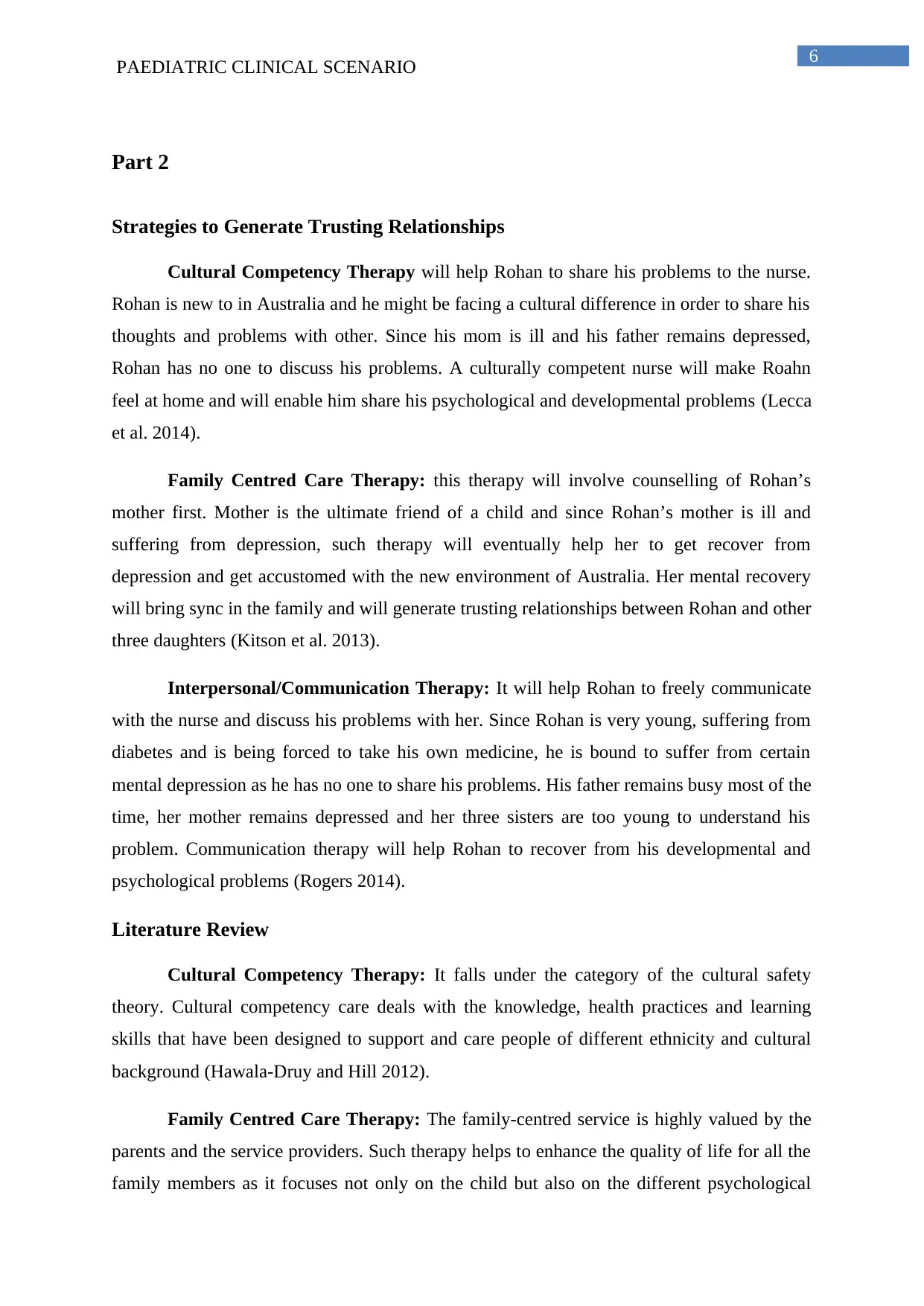
6
PAEDIATRIC CLINICAL SCENARIO
Part 2
Strategies to Generate Trusting Relationships
Cultural Competency Therapy will help Rohan to share his problems to the nurse.
Rohan is new to in Australia and he might be facing a cultural difference in order to share his
thoughts and problems with other. Since his mom is ill and his father remains depressed,
Rohan has no one to discuss his problems. A culturally competent nurse will make Roahn
feel at home and will enable him share his psychological and developmental problems (Lecca
et al. 2014).
Family Centred Care Therapy: this therapy will involve counselling of Rohan’s
mother first. Mother is the ultimate friend of a child and since Rohan’s mother is ill and
suffering from depression, such therapy will eventually help her to get recover from
depression and get accustomed with the new environment of Australia. Her mental recovery
will bring sync in the family and will generate trusting relationships between Rohan and other
three daughters (Kitson et al. 2013).
Interpersonal/Communication Therapy: It will help Rohan to freely communicate
with the nurse and discuss his problems with her. Since Rohan is very young, suffering from
diabetes and is being forced to take his own medicine, he is bound to suffer from certain
mental depression as he has no one to share his problems. His father remains busy most of the
time, her mother remains depressed and her three sisters are too young to understand his
problem. Communication therapy will help Rohan to recover from his developmental and
psychological problems (Rogers 2014).
Literature Review
Cultural Competency Therapy: It falls under the category of the cultural safety
theory. Cultural competency care deals with the knowledge, health practices and learning
skills that have been designed to support and care people of different ethnicity and cultural
background (Hawala-Druy and Hill 2012).
Family Centred Care Therapy: The family-centred service is highly valued by the
parents and the service providers. Such therapy helps to enhance the quality of life for all the
family members as it focuses not only on the child but also on the different psychological
PAEDIATRIC CLINICAL SCENARIO
Part 2
Strategies to Generate Trusting Relationships
Cultural Competency Therapy will help Rohan to share his problems to the nurse.
Rohan is new to in Australia and he might be facing a cultural difference in order to share his
thoughts and problems with other. Since his mom is ill and his father remains depressed,
Rohan has no one to discuss his problems. A culturally competent nurse will make Roahn
feel at home and will enable him share his psychological and developmental problems (Lecca
et al. 2014).
Family Centred Care Therapy: this therapy will involve counselling of Rohan’s
mother first. Mother is the ultimate friend of a child and since Rohan’s mother is ill and
suffering from depression, such therapy will eventually help her to get recover from
depression and get accustomed with the new environment of Australia. Her mental recovery
will bring sync in the family and will generate trusting relationships between Rohan and other
three daughters (Kitson et al. 2013).
Interpersonal/Communication Therapy: It will help Rohan to freely communicate
with the nurse and discuss his problems with her. Since Rohan is very young, suffering from
diabetes and is being forced to take his own medicine, he is bound to suffer from certain
mental depression as he has no one to share his problems. His father remains busy most of the
time, her mother remains depressed and her three sisters are too young to understand his
problem. Communication therapy will help Rohan to recover from his developmental and
psychological problems (Rogers 2014).
Literature Review
Cultural Competency Therapy: It falls under the category of the cultural safety
theory. Cultural competency care deals with the knowledge, health practices and learning
skills that have been designed to support and care people of different ethnicity and cultural
background (Hawala-Druy and Hill 2012).
Family Centred Care Therapy: The family-centred service is highly valued by the
parents and the service providers. Such therapy helps to enhance the quality of life for all the
family members as it focuses not only on the child but also on the different psychological
Paraphrase This Document
Need a fresh take? Get an instant paraphrase of this document with our AI Paraphraser
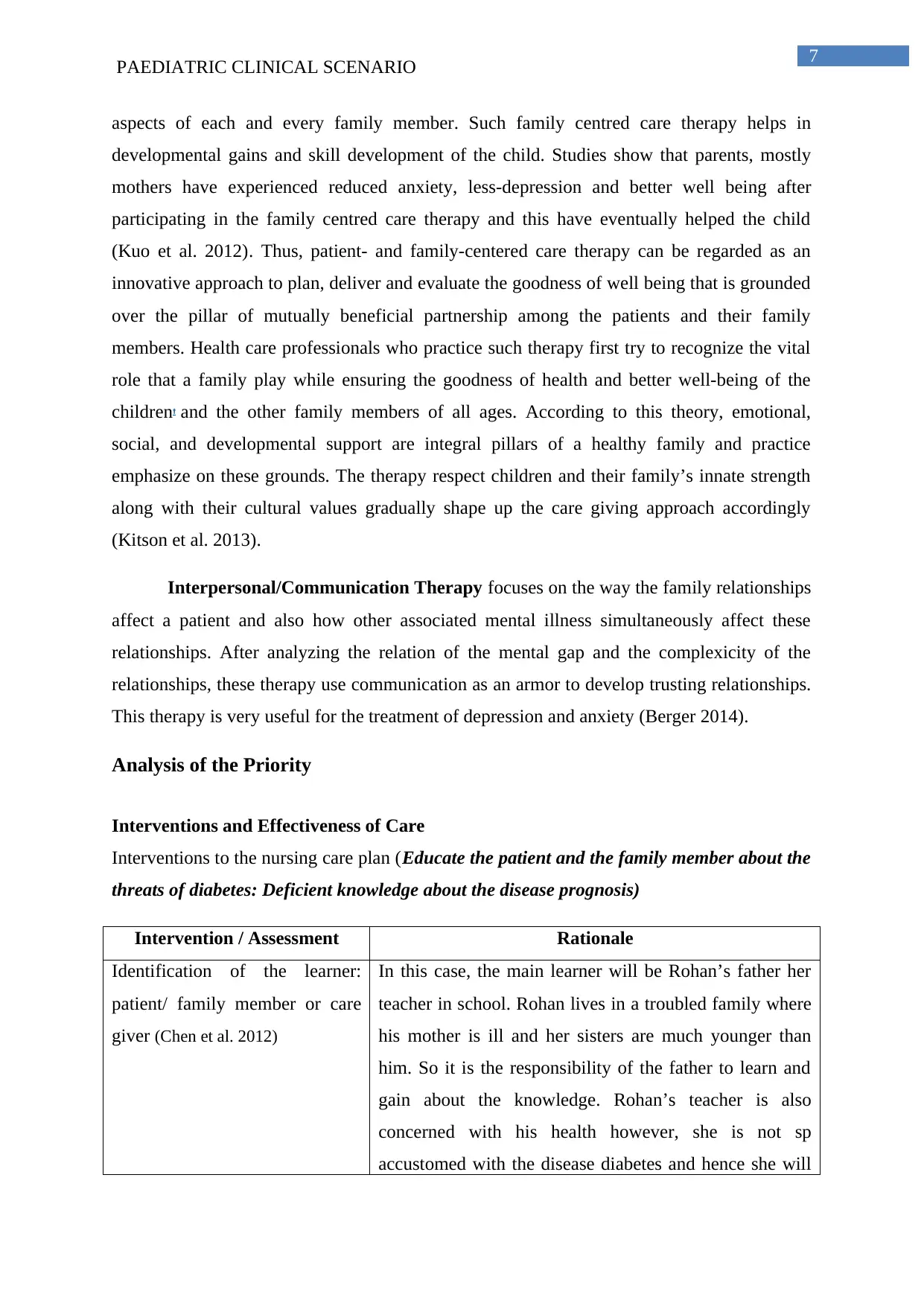
7
PAEDIATRIC CLINICAL SCENARIO
aspects of each and every family member. Such family centred care therapy helps in
developmental gains and skill development of the child. Studies show that parents, mostly
mothers have experienced reduced anxiety, less-depression and better well being after
participating in the family centred care therapy and this have eventually helped the child
(Kuo et al. 2012). Thus, patient- and family-centered care therapy can be regarded as an
innovative approach to plan, deliver and evaluate the goodness of well being that is grounded
over the pillar of mutually beneficial partnership among the patients and their family
members. Health care professionals who practice such therapy first try to recognize the vital
role that a family play while ensuring the goodness of health and better well-being of the
children† and the other family members of all ages. According to this theory, emotional,
social, and developmental support are integral pillars of a healthy family and practice
emphasize on these grounds. The therapy respect children and their family’s innate strength
along with their cultural values gradually shape up the care giving approach accordingly
(Kitson et al. 2013).
Interpersonal/Communication Therapy focuses on the way the family relationships
affect a patient and also how other associated mental illness simultaneously affect these
relationships. After analyzing the relation of the mental gap and the complexicity of the
relationships, these therapy use communication as an armor to develop trusting relationships.
This therapy is very useful for the treatment of depression and anxiety (Berger 2014).
Analysis of the Priority
Interventions and Effectiveness of Care
Interventions to the nursing care plan (Educate the patient and the family member about the
threats of diabetes: Deficient knowledge about the disease prognosis)
Intervention / Assessment Rationale
Identification of the learner:
patient/ family member or care
giver (Chen et al. 2012)
In this case, the main learner will be Rohan’s father her
teacher in school. Rohan lives in a troubled family where
his mother is ill and her sisters are much younger than
him. So it is the responsibility of the father to learn and
gain about the knowledge. Rohan’s teacher is also
concerned with his health however, she is not sp
accustomed with the disease diabetes and hence she will
PAEDIATRIC CLINICAL SCENARIO
aspects of each and every family member. Such family centred care therapy helps in
developmental gains and skill development of the child. Studies show that parents, mostly
mothers have experienced reduced anxiety, less-depression and better well being after
participating in the family centred care therapy and this have eventually helped the child
(Kuo et al. 2012). Thus, patient- and family-centered care therapy can be regarded as an
innovative approach to plan, deliver and evaluate the goodness of well being that is grounded
over the pillar of mutually beneficial partnership among the patients and their family
members. Health care professionals who practice such therapy first try to recognize the vital
role that a family play while ensuring the goodness of health and better well-being of the
children† and the other family members of all ages. According to this theory, emotional,
social, and developmental support are integral pillars of a healthy family and practice
emphasize on these grounds. The therapy respect children and their family’s innate strength
along with their cultural values gradually shape up the care giving approach accordingly
(Kitson et al. 2013).
Interpersonal/Communication Therapy focuses on the way the family relationships
affect a patient and also how other associated mental illness simultaneously affect these
relationships. After analyzing the relation of the mental gap and the complexicity of the
relationships, these therapy use communication as an armor to develop trusting relationships.
This therapy is very useful for the treatment of depression and anxiety (Berger 2014).
Analysis of the Priority
Interventions and Effectiveness of Care
Interventions to the nursing care plan (Educate the patient and the family member about the
threats of diabetes: Deficient knowledge about the disease prognosis)
Intervention / Assessment Rationale
Identification of the learner:
patient/ family member or care
giver (Chen et al. 2012)
In this case, the main learner will be Rohan’s father her
teacher in school. Rohan lives in a troubled family where
his mother is ill and her sisters are much younger than
him. So it is the responsibility of the father to learn and
gain about the knowledge. Rohan’s teacher is also
concerned with his health however, she is not sp
accustomed with the disease diabetes and hence she will
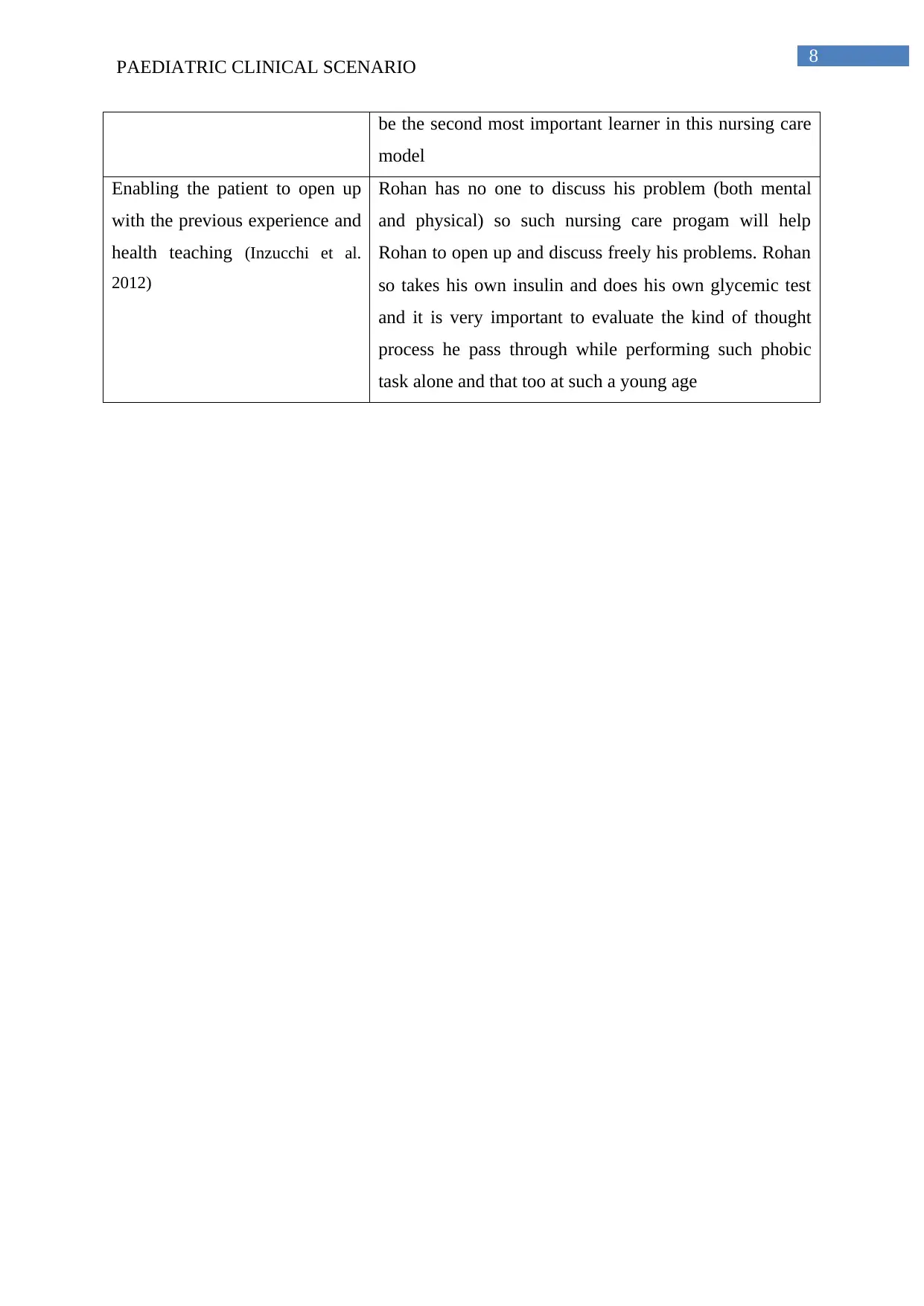
8
PAEDIATRIC CLINICAL SCENARIO
be the second most important learner in this nursing care
model
Enabling the patient to open up
with the previous experience and
health teaching (Inzucchi et al.
2012)
Rohan has no one to discuss his problem (both mental
and physical) so such nursing care progam will help
Rohan to open up and discuss freely his problems. Rohan
so takes his own insulin and does his own glycemic test
and it is very important to evaluate the kind of thought
process he pass through while performing such phobic
task alone and that too at such a young age
PAEDIATRIC CLINICAL SCENARIO
be the second most important learner in this nursing care
model
Enabling the patient to open up
with the previous experience and
health teaching (Inzucchi et al.
2012)
Rohan has no one to discuss his problem (both mental
and physical) so such nursing care progam will help
Rohan to open up and discuss freely his problems. Rohan
so takes his own insulin and does his own glycemic test
and it is very important to evaluate the kind of thought
process he pass through while performing such phobic
task alone and that too at such a young age
⊘ This is a preview!⊘
Do you want full access?
Subscribe today to unlock all pages.

Trusted by 1+ million students worldwide
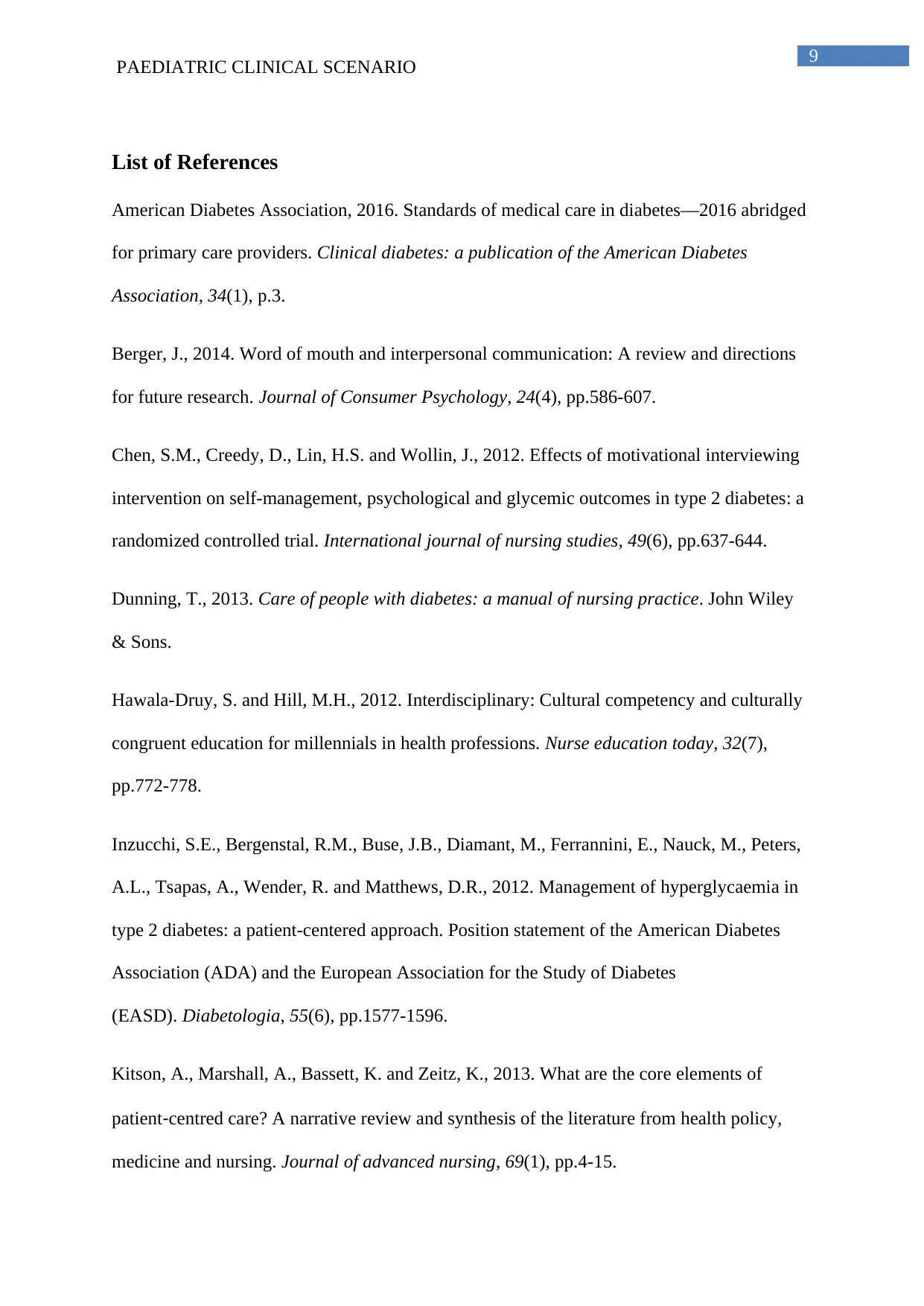
9
PAEDIATRIC CLINICAL SCENARIO
List of References
American Diabetes Association, 2016. Standards of medical care in diabetes—2016 abridged
for primary care providers. Clinical diabetes: a publication of the American Diabetes
Association, 34(1), p.3.
Berger, J., 2014. Word of mouth and interpersonal communication: A review and directions
for future research. Journal of Consumer Psychology, 24(4), pp.586-607.
Chen, S.M., Creedy, D., Lin, H.S. and Wollin, J., 2012. Effects of motivational interviewing
intervention on self-management, psychological and glycemic outcomes in type 2 diabetes: a
randomized controlled trial. International journal of nursing studies, 49(6), pp.637-644.
Dunning, T., 2013. Care of people with diabetes: a manual of nursing practice. John Wiley
& Sons.
Hawala-Druy, S. and Hill, M.H., 2012. Interdisciplinary: Cultural competency and culturally
congruent education for millennials in health professions. Nurse education today, 32(7),
pp.772-778.
Inzucchi, S.E., Bergenstal, R.M., Buse, J.B., Diamant, M., Ferrannini, E., Nauck, M., Peters,
A.L., Tsapas, A., Wender, R. and Matthews, D.R., 2012. Management of hyperglycaemia in
type 2 diabetes: a patient-centered approach. Position statement of the American Diabetes
Association (ADA) and the European Association for the Study of Diabetes
(EASD). Diabetologia, 55(6), pp.1577-1596.
Kitson, A., Marshall, A., Bassett, K. and Zeitz, K., 2013. What are the core elements of
patient‐centred care? A narrative review and synthesis of the literature from health policy,
medicine and nursing. Journal of advanced nursing, 69(1), pp.4-15.
PAEDIATRIC CLINICAL SCENARIO
List of References
American Diabetes Association, 2016. Standards of medical care in diabetes—2016 abridged
for primary care providers. Clinical diabetes: a publication of the American Diabetes
Association, 34(1), p.3.
Berger, J., 2014. Word of mouth and interpersonal communication: A review and directions
for future research. Journal of Consumer Psychology, 24(4), pp.586-607.
Chen, S.M., Creedy, D., Lin, H.S. and Wollin, J., 2012. Effects of motivational interviewing
intervention on self-management, psychological and glycemic outcomes in type 2 diabetes: a
randomized controlled trial. International journal of nursing studies, 49(6), pp.637-644.
Dunning, T., 2013. Care of people with diabetes: a manual of nursing practice. John Wiley
& Sons.
Hawala-Druy, S. and Hill, M.H., 2012. Interdisciplinary: Cultural competency and culturally
congruent education for millennials in health professions. Nurse education today, 32(7),
pp.772-778.
Inzucchi, S.E., Bergenstal, R.M., Buse, J.B., Diamant, M., Ferrannini, E., Nauck, M., Peters,
A.L., Tsapas, A., Wender, R. and Matthews, D.R., 2012. Management of hyperglycaemia in
type 2 diabetes: a patient-centered approach. Position statement of the American Diabetes
Association (ADA) and the European Association for the Study of Diabetes
(EASD). Diabetologia, 55(6), pp.1577-1596.
Kitson, A., Marshall, A., Bassett, K. and Zeitz, K., 2013. What are the core elements of
patient‐centred care? A narrative review and synthesis of the literature from health policy,
medicine and nursing. Journal of advanced nursing, 69(1), pp.4-15.
Paraphrase This Document
Need a fresh take? Get an instant paraphrase of this document with our AI Paraphraser
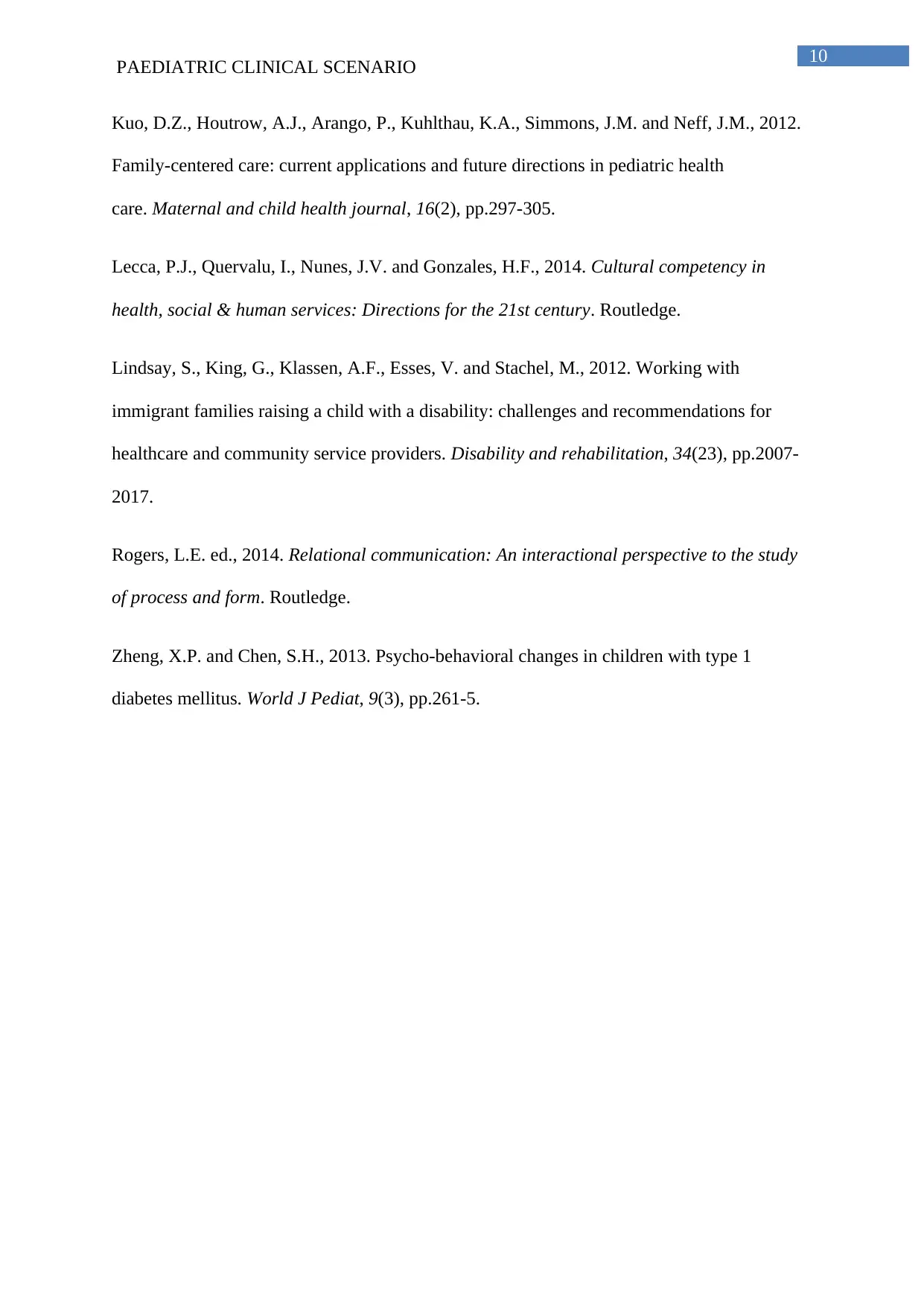
10
PAEDIATRIC CLINICAL SCENARIO
Kuo, D.Z., Houtrow, A.J., Arango, P., Kuhlthau, K.A., Simmons, J.M. and Neff, J.M., 2012.
Family-centered care: current applications and future directions in pediatric health
care. Maternal and child health journal, 16(2), pp.297-305.
Lecca, P.J., Quervalu, I., Nunes, J.V. and Gonzales, H.F., 2014. Cultural competency in
health, social & human services: Directions for the 21st century. Routledge.
Lindsay, S., King, G., Klassen, A.F., Esses, V. and Stachel, M., 2012. Working with
immigrant families raising a child with a disability: challenges and recommendations for
healthcare and community service providers. Disability and rehabilitation, 34(23), pp.2007-
2017.
Rogers, L.E. ed., 2014. Relational communication: An interactional perspective to the study
of process and form. Routledge.
Zheng, X.P. and Chen, S.H., 2013. Psycho-behavioral changes in children with type 1
diabetes mellitus. World J Pediat, 9(3), pp.261-5.
PAEDIATRIC CLINICAL SCENARIO
Kuo, D.Z., Houtrow, A.J., Arango, P., Kuhlthau, K.A., Simmons, J.M. and Neff, J.M., 2012.
Family-centered care: current applications and future directions in pediatric health
care. Maternal and child health journal, 16(2), pp.297-305.
Lecca, P.J., Quervalu, I., Nunes, J.V. and Gonzales, H.F., 2014. Cultural competency in
health, social & human services: Directions for the 21st century. Routledge.
Lindsay, S., King, G., Klassen, A.F., Esses, V. and Stachel, M., 2012. Working with
immigrant families raising a child with a disability: challenges and recommendations for
healthcare and community service providers. Disability and rehabilitation, 34(23), pp.2007-
2017.
Rogers, L.E. ed., 2014. Relational communication: An interactional perspective to the study
of process and form. Routledge.
Zheng, X.P. and Chen, S.H., 2013. Psycho-behavioral changes in children with type 1
diabetes mellitus. World J Pediat, 9(3), pp.261-5.
1 out of 11
Related Documents
Your All-in-One AI-Powered Toolkit for Academic Success.
+13062052269
info@desklib.com
Available 24*7 on WhatsApp / Email
![[object Object]](/_next/static/media/star-bottom.7253800d.svg)
Unlock your academic potential
Copyright © 2020–2025 A2Z Services. All Rights Reserved. Developed and managed by ZUCOL.





